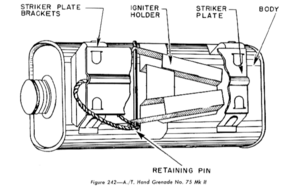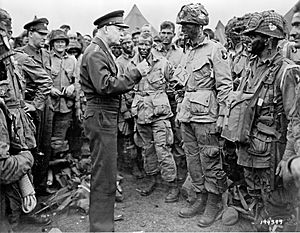Hawkins grenade facts for kids
Quick facts for kids Hawkins grenade |
|
|---|---|

Diagram of a Hawkins grenade, British Explosive Ordnance, NAVORD OP 1665, Naval Ordnance Systems Command (1946), p.384
|
|
| Type | Anti-tank hand grenade/anti-tank mine |
| Place of origin | United Kingdom |
| Service history | |
| In service | 1942 - 1955 |
| Used by | United Kingdom, United States, Canada |
| Wars | World War II |
| Production history | |
| Produced | 1942-? |
| Variants | United States M7 anti-tank mine |
| Specifications | |
| Mass | 1.02 kilograms (2.2 lb) |
| Length | 150 millimetres (5.9 in) |
| Width | 75 millimetres (3.0 in) |
|
|
|
| Filling | Ammonal/TNT |
| Filling weight | 0.45 kilograms (0.99 lb) |
|
Detonation
mechanism |
Crush igniter |
The Hawkins grenade was a special type of bomb used by soldiers in World War II. It was also known as the "Grenade, Hand, Anti-Tank, No. 75." This weapon was created in Britain for the British Army and the Home Guard (a group of volunteer soldiers). It was developed after many British soldiers had to leave France during the Dunkirk evacuation.
The Hawkins grenade first appeared in 1942. It was designed to be more useful than older grenades like the No. 73 grenade or the sticky bomb. It was shaped like a rectangle, about 150 mm (6 inches) long and 75 mm (3 inches) wide. It held about 0.45 kg (1 pound) of explosive material.
When a vehicle drove over the grenade, it would crush a special part inside. This caused acid to leak onto a chemical, which then made the explosive blow up. Soldiers often used several Hawkins grenades together to destroy tanks or damage their tracks. This grenade could also be used as a small demolition charge to blow things up. The British Army used it until 1955. The United States Army also used it and even made their own version called the M7 anti-tank mine.
Contents
Why the Hawkins Grenade Was Developed
After the Battle of France ended, many British soldiers had to leave France from the port of Dunkirk in May and June 1940. Because of this, it seemed very likely that Germany would try to invade Great Britain.
However, the British Army was not ready to defend the country. After the Dunkirk evacuation, they had very few anti-tank guns. Most of their guns were left behind in France. There was also very little ammunition for the guns they still had. Soldiers were not even allowed to use one bullet for training.
Because of these problems, new anti-tank weapons were needed. These weapons would help the British Army and the Home Guard stop German tanks. Many of these new weapons were anti-tank hand grenades. Grenades were good because they could be made quickly and cheaply.
Older grenades included the No. 73 Grenade, which was a bottle filled with TNT. There was also the grenade, hand, anti-tank No. 74, which had a strong glue on it to stick to vehicles. In 1942, the Hawkins grenade appeared. It was designed to be used in many different ways, making it very useful.
How the Hawkins Grenade Was Designed
The Hawkins grenade was shaped like a rectangle. It was about 150 mm (6 inches) long and 75 mm (3 inches) wide. It weighed about 1.02 kg (2.2 pounds). Inside, it had about 0.45 kg (1 pound) of explosive material, usually ammonal or TNT.
On top of the grenade was a plate. Under this plate, a soldier would put a chemical igniter, which acted as the fuse. When a vehicle drove over the grenade, its weight would crush the plate. This would break the igniter, causing acid to leak onto a special chemical. This chemical would then make the explosive blow up.
The grenade could be thrown at a vehicle like a regular grenade. It could also be placed on the ground to act like an anti-tank mine. The Hawkins grenade also had spots where blasting caps or cordtex could be added. This meant it could be used as a demolition charge to blow up other things.
When using the grenade, it was best for the soldier to be close to their target. Hiding in a trench was a good idea. If the target was a tank, the best places to aim were the sides and back. The armor there was usually thinner, and that's where the engine was located.
Hawkins Grenade in Action

The Hawkins grenade was first used in 1942. The British Army continued to use it until 1955. The United States Army also used this grenade. They even created their own version called the "M7 light anti-tank mine."
When used against tanks, several Hawkins grenades could be linked together. They were placed about two feet apart in a "daisy chain" across a road. This was very good at damaging the tracks of tanks. If enough grenades were used together, they could stop a medium tank.
The Hawkins grenade was also used for other jobs, like blowing holes in walls. Because it was small, it could easily be placed on a railway track. When it exploded, it could destroy a section of the track. Soldiers sometimes called it the "Johnson's Wax tin" because it looked like a can of floor wax. During the Battle of Ortona, Canadian troops used them to "mousehole" between buildings. This meant blowing small holes in walls to move from one building to another without going outside.
Who Used the Hawkins Grenade
See also


